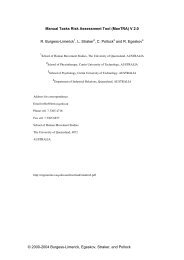d6 - Burgess-Limerick
d6 - Burgess-Limerick
d6 - Burgess-Limerick
- No tags were found...
Create successful ePaper yourself
Turn your PDF publications into a flip-book with our unique Google optimized e-Paper software.
The PErforM risk assessment tool will assist you in recording relevant information about the task,<br />
identifying the manual tasks risk factors, assessing the degree of exposure, developing suitable<br />
controls and prioritising the tasks which are creating the highest risk to your workers.<br />
Completing the risk assessment form provides a record of the risk assessment, and should be kept<br />
on file.<br />
The PErforM risk assessment tool and instructions for completing it are provided in Appendix 1.<br />
<br />
<br />
<br />
The reduction of risk requires the successful implementation of controls which do not introduce<br />
new risk factors into the workplace. There are three elements that require consideration when<br />
planning a control strategy:<br />
1. the effectiveness of the new controls<br />
2. the successful implementation of new controls<br />
3. managing potential new risk factors.<br />
Encouraging work teams to participate throughout the control strategy process is a way to ensure<br />
these elements are considered. Worker participation is critical to the overall success of the control<br />
strategy.<br />
1. Effective controls<br />
To be effective, controls should:<br />
• target the risk factors present in the task<br />
• meet the needs of all workers who will undertake the task.<br />
2. Successful implementation<br />
A number of people will play a role in the implementation of a control strategy. All people who<br />
are likely to have some responsibility at the implementation stage need to be involved from the<br />
very beginning, particularly operators and maintainers who are the ‘hands on’ deliverers of a<br />
control strategy. Involving workers from the beginning and giving genuine consideration to their<br />
input and ideas will give workers a sense of ownership over the proposed controls.<br />
Worker commitment can be achieved by:<br />
• providing clear and specific training associated with the control strategy, such as any<br />
new work methods, safe and appropriate use of tools and equipment, and implementation<br />
timeframes<br />
• communication from management on organisational expectations<br />
• feedback to the work team on the basis of the changes, such as the justification behind<br />
decisions<br />
• recognition of worker commitment to the control strategy.




